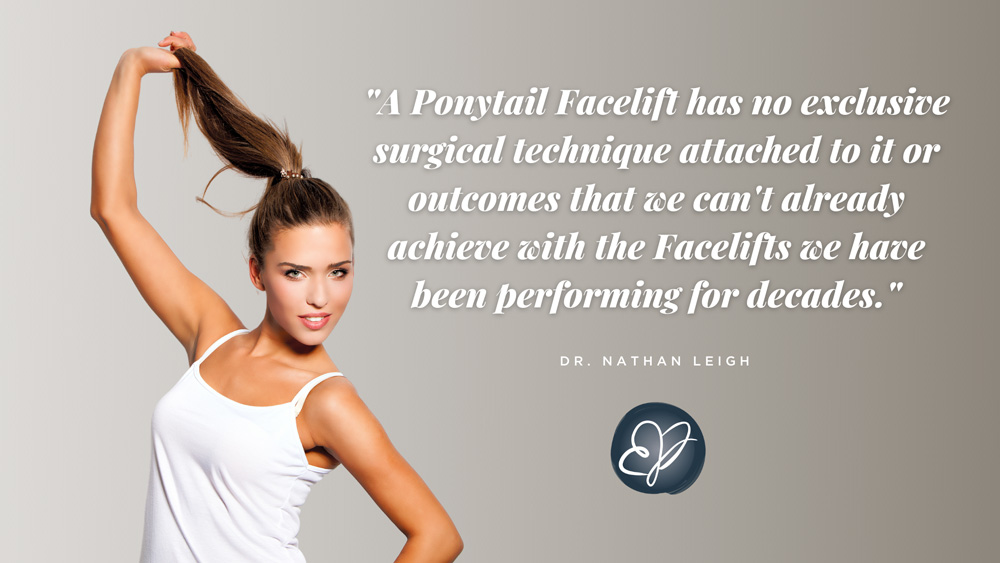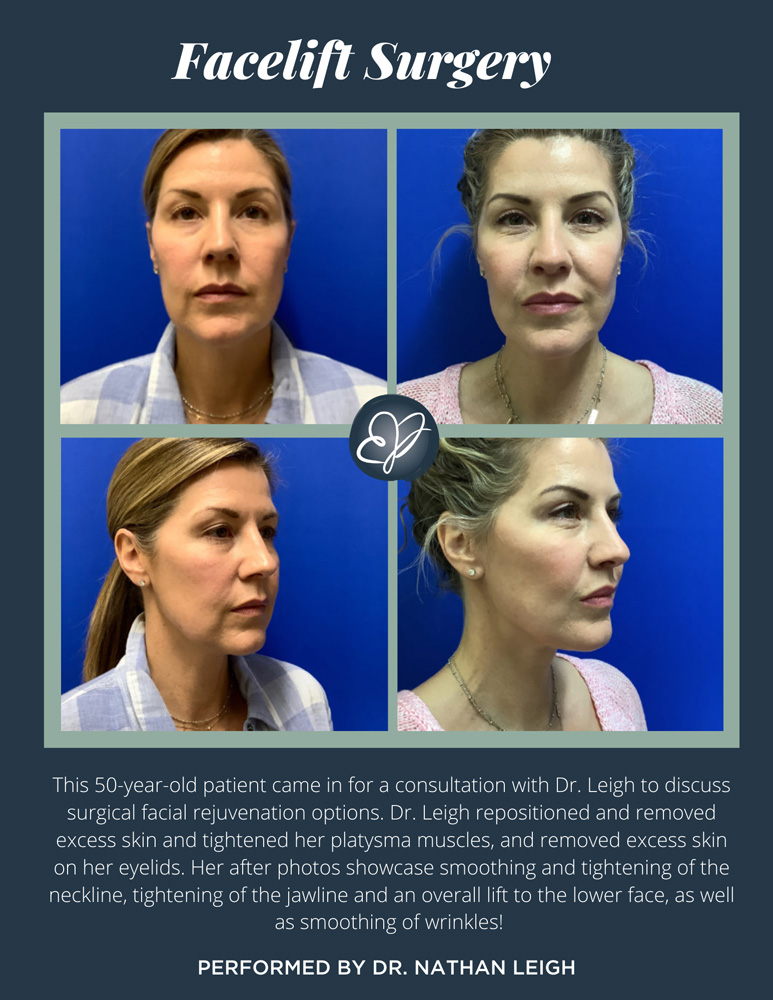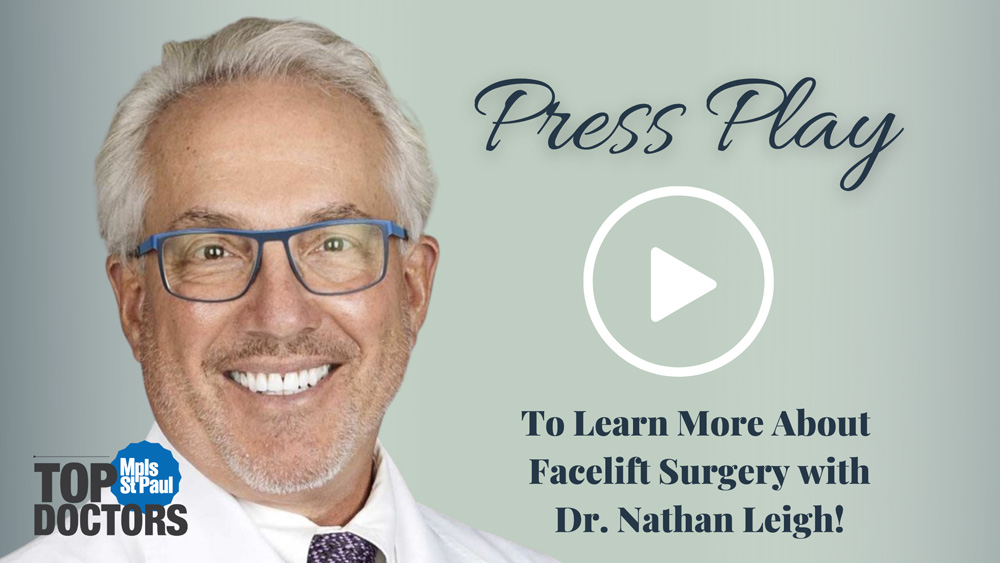Each day seems to welcome a new barrage of buzzwords in the beauty industry. This marketing phenomenon is especially true of plastic surgery and cosmetic procedures. Whether it’s a surgeon trying to generate renewed interest in a particular surgery by calling it something catchy or a social media influencer flaunting their latest’ tweakment” with a follower-boosting hashtag, the influx of trendy names can confuse potential patients and discredit the original surgery. The clickbait titles for Facelift procedures are some of the most extensive, including the popular “Ponytail Facelift.”

What is the “Ponytail Facelift?”
“The internet would have you believe that a Ponytail Facelift is some sensational, new surgical technique, but it’s really just a Facelift that can be customized to a patient’s unique needs and aesthetic goals, just like any other Facelift,” explains Dr. Nathan Leigh, a board-certified plastic surgeon, and partner with Edina Plastic Surgery. “The way the Ponytail Facelift is marketed to patients implies that it mimics the effects a face undergoes when the hair is pulled into a high, tight ponytail, including an elevated brow, smooth forehead, and overall more youthful look. It also forgoes the scars of a traditional Facelift (generally in front of the ears) and allows a patient to wear their hair up without the reservations of concealing post-surgical scars. What they DON’T tell you online is that all of this can already be achieved with a traditional or mini Facelift procedure. A Ponytail Facelift has no exclusive surgical technique attached to it or outcomes that we can’t already achieve with the Facelifts we have been performing for decades.”
Medical Terminology VS Marketing Clickbait
When researching plastic surgery procedures online, patients must understand the difference between a marketing buzzword and a valid medical procedure. When it comes to Facelift surgery, a mini, deep plane, or SMAS Facelift are real, viable surgical techniques. Nowhere in a plastic surgeons’ training will they encounter the “ponytail” technique in a medical textbook or be asked to perform it in their residency.
“A plastic surgeon may specialize in a certain aesthetic when it comes to how they perform Facelift surgery, or they may trademark a fancy name for their Facelift for marketing purposes, but at the end of the day, a Facelift is a Facelift, and the approach your surgeon will take with yours is unique to you, your facial anatomy, and your aesthetic goals,” states Dr. Leigh.
Ponytail Facelift “aka” Limited Endoscopic Facelift
“Depending on where you are in the world and what part of the United States you reside in, a Facelift may mean something slightly different to every plastic surgeon,” says Dr. Leigh. “For example, one surgeon may call a procedure a mini Facelift while another refers to it as partial or lower Facelift. This can be frustrating for patients researching procedures on the internet because marketing terms frequently search better online than actual procedure names because of digital algorithms. Rest assured, a qualified and experienced plastic surgeon will focus on giving you the Facelift YOU need and pay little attention to what is trending online unless it directly influences your desired aesthetic outcome.”
Although surgeons may not recognize the name Ponytail Facelift, many would agree to call it a limited endoscopic lift due to its minimal post-surgical scarring when faced with the details of the procedure. This surgical approach means that small incisions are made within the hairline by the temples, a small instrument and camera are inserted through the opening, and suspension sutures are used to elevate the midface, thus making scarring discreet.

“Although less invasive, an endoscopic-only approach to a Facelift can be very limiting,” shares Dr. Leigh. “With this method, a surgeon can lift underlying connective tissue but can’t address any skin laxity at the surface. This loose skin is usually excised and removed during traditional Facelift surgery. An endoscopic approach may work well for younger patients with tighter skin quality but look incomplete on a more mature patient. Also, placing an incision within the hairline can potentially cause irregular hair regrowth or hair loss by damaging surrounding hair follicles.”
A Procedure’s Name VS a Plastic Surgeon’s Good Name and Reputation
Explaining how you want your face and skin to look like it does when you pull your hair into a high ponytail is a much more constructive point to share with your plastic surgeon during a consultation than asking them if they perform the Ponytail Facelift. Avoid becoming too focused on a surgical trend or fad you see on social media and, instead, channel that time and energy into researching and selecting a board-certified, experienced, and qualified plastic surgeon who you feel confident partnering with.
“As plastic surgeons, we care about you and your results,” states Dr. Leigh. “Our interest in surgical trends and fads is mostly limited to how it impacts the aesthetic desires of our patients because we need to be on the same wavelength about the outcome you expect from surgery. I encourage anyone searching for a specific plastic surgery online to invest just as much effort in researching the credentials and qualifications of prospective surgeons. This, more than any trend, will ensure you get the safest and best result that is custom-tailored to you, regardless of what it’s named.”
Are you interested in discussing Facelift surgery with Dr. Leigh or another board-certified plastic surgeon at Edina Plastic Surgery? Begin your journey by scheduling a complimentary consultation today! Call (612) 688-3177, text (952) 925-1765, or CLICK HERE to get started.



